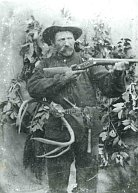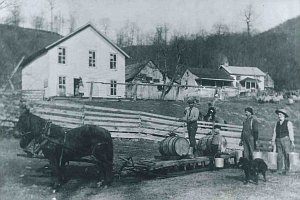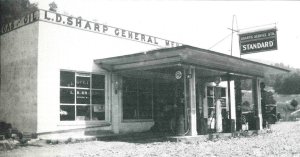March 4, 2008: We won! The eminent domain controversy is over. This website remains "as-was" to serve as a testament to the hard work that a lot of people put in over the past few years. Let us remember the lessons learned from this struggle.
The information below has been obtained from official Sharp family websites and through discussions with family.
In places, the text is contextualized in blue with present-day surroundings and concerns.
The Sharps of Slatyfork
Getting to Slatyfork: The First Three Generations
The Sharp family tree of Pocahontas County begins with William Sharp; not in Slatyfork actually, but south-east about 15 miles in Huntersville. He built the first house there in the 1700s. He served in the Indian and Revolutionary Wars. And he begat William II.
William II settled north-west of Huntersville in a village named Edray, where he begat William III.
William III settled north of Edray in what today is Slatyfork and built the first house there, a log home. It was constructed alongside Laurel Run where Big Spring Fork and Old Field Fork come together to form the Upper Elk River (this is the area behind present-day Beckwith Lumber).
The Fourth Generation - and the Civil War
William Sharp III had 6 boys and a girl. Silas, Harmon, Hugh, William (Luther) IV, Bernard, Henry, and Mary Eleanor.
He built a second log home a little ways up Big Spring Fork, alongside a large cold-water springs complex (behind Evva Shelton's current place), and the family moved there; except for his son Harmon who continued to live in the first log home at Laurel Run.
His son Hugh later built a third log home nearby (it pristinely stands today, behind the Sharp's Country Store).
Mary Eleanor died of diphtheria in 1861. She was buried in an unmarked grave in a nearby field (the exact proposed construction site).
Bernard fought in the Civil War for the North, while Henry fought for the South. They were both killed.
During the war, Silas took refuge for about a year in a cave on Middle Mountain (up behind the present-day farm house). One evening he came down to enjoy an Easter dinner, but Confederate troops in the valley at that time had learned he was there and arrested him as a spy. William Luther bolted out of the house, but was killed when a soldier by the name of Simmons shot him in the back. He was buried next to Mary Eleanor.
Silas was taken as a prisoner of war to Salisbury, North Carolina where he was imprisoned for 2 years. He was one of just a few known to survive the notorious camp. When released, Silas walked some 300 miles back to Slatyfork from Salisbury.
Silas then built a house south of Hugh's home, over the hill near the stream of Slaty Fork (from which the area gets its name), along the now-abandoned Huttonsville-Huntersville Turnpike.
The Fifth Generation
Silas Sharp had a son named Luther David (L.D.). In 1884 at the age of 12, L.D. began selling scarves and ink out of his mother’s bedroom to travelers passing by. When the business outgrew his family's house, L.D. built his first store building. It was one room, made from lumber cut by loggers working the nearby mountains.
During his time there, L.D. built another house, which was attached to his parent's house. He also built a large cellar and, when his one-room store became too small for business, he constructed a larger two-story building around and above it.
In 1926, the state decided to abandon the section of roadway along which the Sharps had built their livelihood and instead developed the alternate route along Seneca Trail, known today as route 219. This meant that, likewise, L.D. and family had to abandon a generation's worth of work and home, to start again along the new route 219. So it is in 1926 that the Sharp's Country Store we know today was constructed.
The Sixth Generation
L.D. Sharp had 4 sons and 3 daughters: The sons were Ivan, Paul, Si, and Luther David Jr. ("Dave"). The daughters were Ada, Violet, and Creola.
Ivan was the oldest and ran one side of the store selling parts for something new called automobiles.
After graduating from WV Wesleyan, Paul became the principal of Seneca Trail Consolidated School (the same building that today houses the Beckwith Lumber offices).
Dave Sharp passed away November 17, 2007.
The Seventh Generation
Ivan Sharp had 2 sons and a daughter: Ralph, Evan, and Ramona.
Paul Sharp was married twice, first to Vonda Lowe (also a Wesleyan graduate) and - after she died - to Kitha. Paul had a daughter named Barbara Jane and a son named Thayer.
Dave Sharp had a daughter named Linda.
The Eighth Generation
Ralph has 5 children: Vicki, Brian, Kathy, Dianne, and Richard.
Evan had 3 children: Todd, Roderick, and Jeanette.
Ramona married a man by the name of Thomas N. Shipley, and has 3 sons: John, Tom, and David.
Barbara married a man by the name of Smith and has 3 daughters: Melinda, Cynthia, and Suzanne.
Linda has 3 children: Matthew, Bridget, and Virginia.
Of the many from this generation, it is son Tom Shipley who presently keeps watch over the Sharp family heritage in Pocahontas County. He runs their country store and keeps their land. And he fights to save their field - a field that belongs equally to the County's rich history - from the current efforts which threaten to destroy not only a remarkable and storied family tree, but also an irreplaceable part of the soul of Pocahontas County Herself.
The Ninth Generation
There are presently 5 ninth generation members.
Other Highlights
At the location of the second log home constructed by William III (the one that was behind Evva Shelton's home), Indian arrowheads, spear points, cup stones, and burial pendants have been found dating back to 7700 BC. Burial grounds exist there as well, and also in another Sharp field across Big Spring Fork.
General Robert E. Lee ate supper in Hugh's old log house (the one behind the store today). General Lee and his Confederate army encamped at nearby Linwood in 1862.
The old Sharp's Country Store is listed in the Pocahontas County registration of historical buildings, as is Hugh's log house.
Photos used with permission.


